Add lookup files
The data models and pivots that you create in this tutorial require some fields from an external lookup file. This topic guides you through the steps to add the lookup to your Splunk deployment and create a new lookup definition.
With CSV lookups, you can reference fields in an external CSV file that match fields in your event data. Using this match, you can enrich your event data by adding more meaningful information and searchable fields to each event. For this tutorial the lookup file maps the productId in the tutorial data to a product name and price in the lookup file.
The remaining Parts in this tutorial dependent on you completing the steps in this section. If you do not configure the lookup, the data models and pivots will not produce the correct results.
If you completed the Search Tutorial, you can skip this step and go to Part 2: Building a data model.
Download and uncompress the lookup file
- Download the Prices.csv.zip file.
- Uncompress the file.
- The
prices.csvfile contains the product names, price, and code. For example:
- The
productId product_name price sale_price Code DB-SG-G01 Mediocre Kingdoms 24.99 19.99 A DC-SG-G02 Dream Crusher 39.99 24.99 B FS-SG-G03 Final Sequel 24.99 16.99 C WC-SH-G04 World of Cheese 24.99 19.99 D
Find the Lookups manager
- In the Splunk bar, click Settings.
- In the Knowledge section, click Lookups.
Upload the lookup table file
To use a lookup table file, you must upload the file to your Splunk platform.
- In the Lookups manager, locate Lookup table files.
- In the Actions column click Add new.
- The Destination app field specifies which app you want to upload the lookup table file to. To upload the file in the Search app, you do not need to change anything. The default value is search.
- Under Upload a lookup file, click Choose File and browse for the prices.csv file.
- Under Destination filename, type
prices.csv.- This is the name that you will use to refer to the file when you create a lookup definition.
- Click Save.
- This uploads your lookup file to the Search app and displays the lookup table files list.
If the Splunk software does not recognize or cannot upload the file, you can take the following actions.
- Check that the file is uncompressed.
- If an error message indicates that the file does not have line breaks, the file has become corrupted. This can happen if the file is opened in Microsoft Excel before it is uploaded. You should delete the
Prices.csv.zipandprices.csvfiles. Then download the ZIP file again, and uncompress the file.
The other lookup table files in the list are included with the Splunk software.
Now that the lookup table file is uploaded, you need tell the Splunk software which applications can use this file. You can share the lookup table file with the Search app or with all of the apps.
- In the Lookup table files list, locate the
prices.csvfile at the bottom of the Path list. - In the Sharing column, notice that
prices.csvis listed as Private. - To share the lookup table file, click Permissions.
- In the Permissions dialog box, under Object should appear in, select All apps.
- Click Save.
Add the field lookup definition
It is not sufficient to share the lookup table file with an application. You must create a lookup definition from the lookup table file.
- In the Lookup table file view, select Lookups in the breadcrumbs to return to the Lookups manager.
- For Lookup definitions, click Add New.
- The Add new lookups definitions page opens, where you define the field lookup.
- There is no need to change the Destination app setting. It is already set to search, referring to the Search app.
- For Name, type
prices_lookup. - For Type, select File-based.
- A file-based lookup is typically a static table, such as a CSV file.
- For Lookup file, select prices.csv, which is the name of the lookup table file that you created.
- For Configure time-based lookup and Advanced options, leave the check boxes unselected.
- Click Save.
Now that you have created the lookup definition, you need to specify in which apps you want to use the definition.
- In the Lookup definitions list, for the prices_lookup, click Permissions.
- In the Permissions dialog box, under Object should appear in, select All apps.
- Click Save.
- In the Lookup definitions page, prices_lookup now has Global permissions.
You can use this field lookup to add information from the lookup table file to your events. You use the field lookup by specifying the lookup command in a search string. Or, you can set the field lookup to run automatically.
Next steps
Continue to the next section to learn about data models and how to create them.
| Load the tutorial data | About data models and data model datasets |
This documentation applies to the following versions of Splunk® Enterprise: 7.0.0, 7.0.1, 7.0.2, 7.0.3, 7.0.4, 7.0.5, 7.0.6, 7.0.7, 7.0.8, 7.0.9, 7.0.10, 7.0.11, 7.0.13

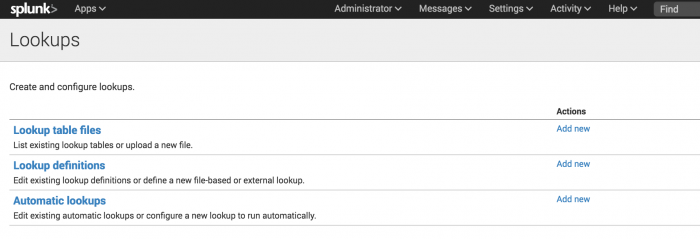
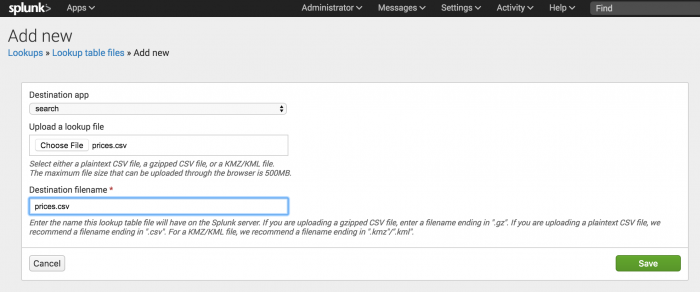

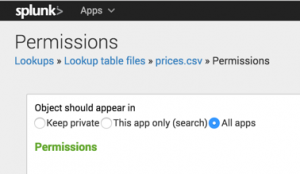


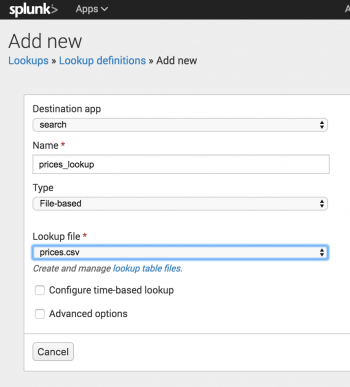

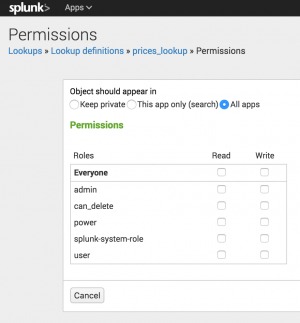
 Download manual
Download manual
Feedback submitted, thanks!